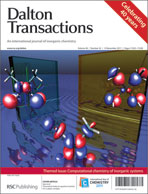Cobalt(II) diketonate complexes, such as bis[trifluoroacetylacetonato(−1)]cobalt(II) [Co(tfa)2], catalyze the aerobic oxidation of alkenols into functionalized tetrahydrofurans. To gain insight into activation of triplet dioxygen by Co(tfa)2 in a protic solvent, as used in oxidation catalysis, the electronic structure of aquabis[trifluoroacetylacetonato(−1)]cobalt(II)—Co(tfa)2(H2O)—and the derived dioxygen adduct were characterized using ab initio (CASSCF, NEVPT2) and density functional theory (BP86, TPSSh, B3LYP) methods. The ground state of Co(tfa)2(H2O) is a high-spin, quartet state. As dioxygen approaches the cobalt atom, the quartet state couples with a triplet dioxygen molecule and forms a sextet, a quartet, and a doublet spin state with the high-spin state being the lowest in energy. At the equilibrium Co–O2 distance of 1.9 Å, Co(tfa)2(H2O)(O2) has a doublet superoxo Co(III) ground state with the unpaired electron residing on the oxygen moiety, in a nearly unchanged O2 π* orbital.
![Graphical abstract: How molecular oxygen binds to bis[trifluoroacetylacetonato(−1)]cobalt(ii) – ab initio and density functional theory studies](/en/Image/Get?imageInfo.ImageType=GA&imageInfo.ImageIdentifier.ManuscriptID=C1DT10724K&imageInfo.ImageIdentifier.Year=2011)
You have access to this article
 Please wait while we load your content...
Something went wrong. Try again?
Please wait while we load your content...
Something went wrong. Try again?
![Graphical abstract: How molecular oxygen binds to bis[trifluoroacetylacetonato(−1)]cobalt(ii) – ab initio and density functional theory studies](/en/Image/Get?imageInfo.ImageType=GA&imageInfo.ImageIdentifier.ManuscriptID=C1DT10724K&imageInfo.ImageIdentifier.Year=2011)

 Please wait while we load your content...
Please wait while we load your content...